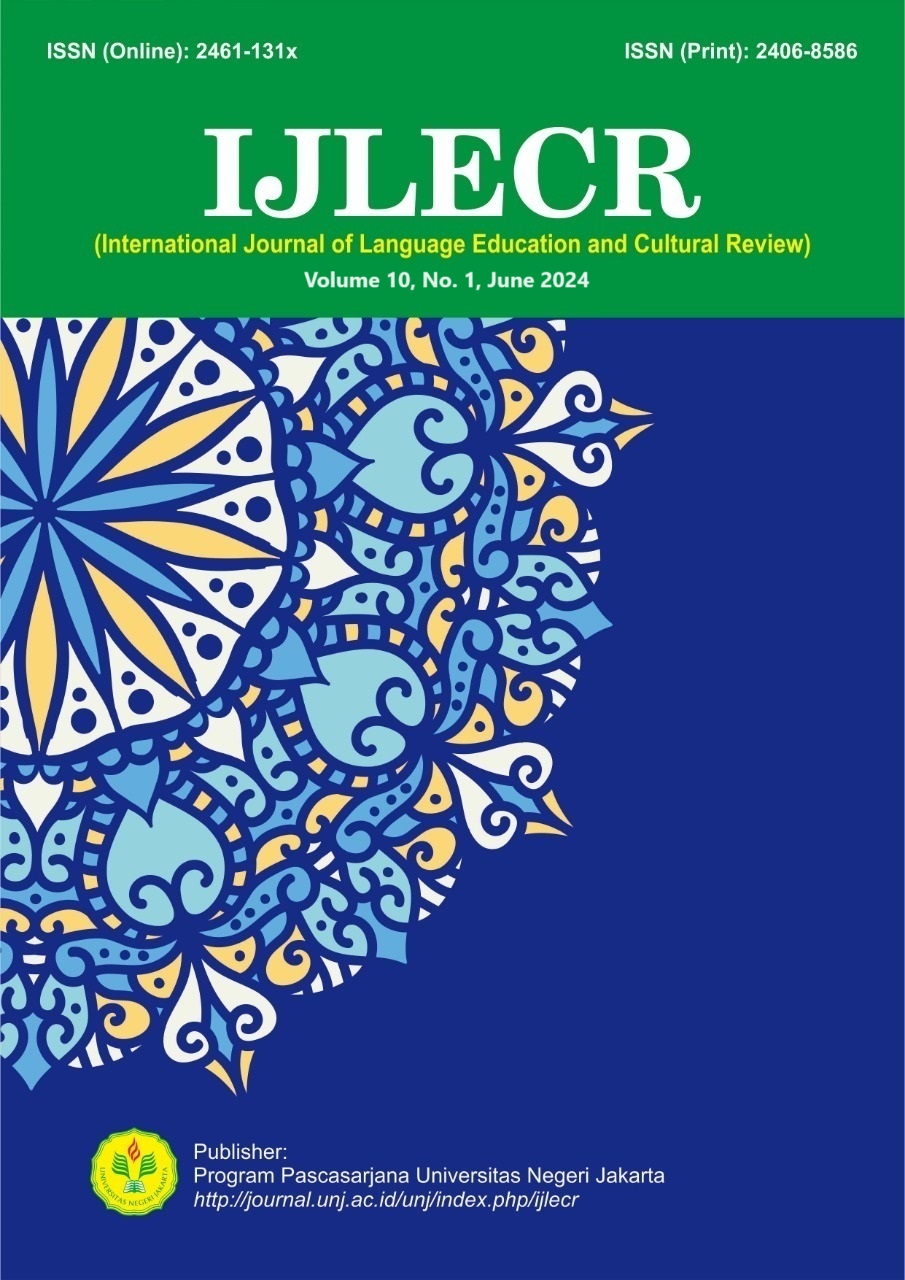Intermediate Students' Perceptions of the Transformation of Online Translation Engine
DOI:
https://doi.org/10.21009/ijlecr.v10i1.45004Kata Kunci:
Language Translation Machine, Technology, Transformation, PlatformAbstrak
Online language translation machine is a tool that is currently popular to be used as a benchmark when translating words and sentences from foreign languages that are widely used by people today, especially students and students who can change the way of learning foreign languages by facilitating the translation process. Currently, online translation machines are really increasing and varying from those available on the website to having their own platforms such as special applications for language translation machines, so this research appears to analyse online translation machines according to students who have used them, this research method is a qualitative method conducted through a platform using interviews that see from the perception or point of view of users, namely high school students. The results of the interviews found that out of 13 students have almost the same point of view but with a variety of different reasons, most of them say that the translation machine is growing rapidly and is increasingly sophisticated as evidenced by the existence of new and interesting features that make it easier for them to translate various languages. It can be concluded that their perception of the online translation machine is interesting and quite realistic that the current online translation machine is indeed growing quite rapidly starting from the features and translation accuracy that continues to increase, it will be sure for the future online translation machines will be more sophisticated and become the main tool in translating various languages.
Referensi
Bavendiek, U. (2022). Using machine translation as a parallel text to access literature for modern language learning. In Innovative language teaching and learning at university: facilitating transition from and to higher education (pp. 57–67). https://files.eric.ed.gov/fulltext/ED619885.pdf
Chang, Li-Ching. (2022). Chinese language learners evaluating machine translation accuracy. JALT CALL Journal, 18(1), 110–136. https://doi.org/10.29140/jaltcall.v18n1.592
Cherchata, L., Korol, L., Rubchak, O., Orda, O., & Novytska, D. (2023). Effectiveness of translation transformations in different styles of the english language for teaching written translation. Amazonia Investiga, 12(67), 185-197.
Creswell, J. W. (2009). Research design: Pendekatan kualitatif, kuantitatif, dan mixed. Yogyakarta: Pustaka Pelajar.
Kembaren, F. R., Hasibuan, A. K., & Natasya, A. (2023). Technology trends in translation: A Comparative analysis of machine and human translation. Absorbent Mind: Journal of Psychology and Child Development 3(2), https://ejournal.insuriponorogo.ac.id/index.php/absorbent_mind/article/download/4486/2488/
Khairani, A. F., Permana, P., & Permatawati, I. (2020). Google translate in perceptions of German language students. In 4th International Conference on Language, Literature, Culture, and Education (ICOLLITE 2020) (pp. 69-74). Atlantis Press.
Kučiš, V., & Seljan, S. (2014). The role of online translation tools in language education. Babel, 60(3), 303-324.
Mahdi, H. S., Alotaibi, H., & AlFadda, H. (2022). Effect of using mobile translation applications for translating collocations. Saudi Journal of Language Studies, 2(4), 205–219.
Margiana, M., & Syafryadin, S. (2023). Students’ perception of the use google translate in English learning. Jadila: Journal of Development and Innovation in Language and Literature Education, 3(2), 171-182.
Marito, S., & Ashari, E. (2017). EFL students’ perception about machine translation. Jurnal Dimensi, 6(2).
Molino, A. (2023). Artificial intelligence and machine translation: Perceptions, opinions and experiences of italian graduate students of English as a foreign language. In Multilinguisme et variétés linguistiques en Europe à l’aune de l’intelligence artificielle Multilinguismo e variazioni linguistiche in Europa nell’era dell’intelligenza artificiale Multilingualism and Language Varieties in Europe in the Age of Artificial Intelligence (pp. 337-353). Ledizioni.
Muftah, M. (2022). Machine vs human translation: a new reality or a threat to professional Arabic–English translators.
Nurhazanna, S. (2023). Students' perception of using google translate in practicum in translation and interpretation course at English Education Department UIN Suska Riau (Doctoral dissertation, Universitas Islam Negeri Sultan Syarif Kasim Riau).
Pastor, D. G. (2021). Introducing machine translation in the translation classroom: A survey on students’ attitudes and perceptions. Revista Tradumatica, (19), 47–65.
Paterson, K. (2023). Machine translation in higher education: Perceptions, policy, and pedagogy. TESOL Journal, 14(2), 690.
Powell, N., Baldwin, J., & Manning, J. (2022). Graduate STEM student perspectives and implementation of machine translators in South Korea.
Pratiwi, N. F., Sujaini, H., & Nyoto, R. D. (2017). Pengembangan antarmuka mesin penerjemah statistik multibahasa berbasis web. JUSTIN (Jurnal Sistem dan Teknologi Informasi), 5(1), 52-55.
Sagita, M., Jamaliah, J., & Balqis, N. (2021). Students’ perception about google translation tool in learning English. Getsempena English Education Journal, 8(1), 26-40.
Sofia, D. (2022). Students’perception towards the use of machine translation in translation class. Skripsi. UIN Antasari Banjarmasin. https://idr.uin-antasari.ac.id/20476/
Sugiyono. (2018). Metode penelitian kuantitatif, kualitatif, dan R&D. Bandung: Penerbit Alfabeta
Sujarwo, S. (2020). Students’ perceptions of using machine translation tools in the EFL classroom. Al-Lisan: Jurnal Bahasa (e-Journal), 5(2), 230-241.
Syafitri, N. L. (2022). The students'perception toward the use of google translate in learning English at English education students of Raden Fatah State Islamic University Palembang (Doctoral dissertation, 021008 Universitas Tridinanti Palembang).
Wai-Chan, S. (2012). Teknologi terjemahan: Dahulu, sekarang dan masa depan. Jurnal Terjemahan Alam & Tamadun Melayu, 4(1), 25-44.
Wang, J., & Ke, X. (2022). Integrating machine translation into EFL writing instruction: process, product and perception. Journal of Language Teaching and Research, 13(1), 125-137. https://jltr.academypublication.com/index.php/jltr/article/view/2044
Yanti, M., & Meka, L. M. C. (2019). The students’ perception in using Google Translate as a media in translation class. Proceedings of International Conference on English Language Teaching (INACELT), 3(1), 128–146. https://e-proceedings.iain-palangkaraya.ac.id/index.php/INACELT/article/view/89
Ye, Y. (2021). Translation mechanism of neural machine algorithm for online english resources. Complexity, April. https://doi.org/10.1155/2021/5564705








